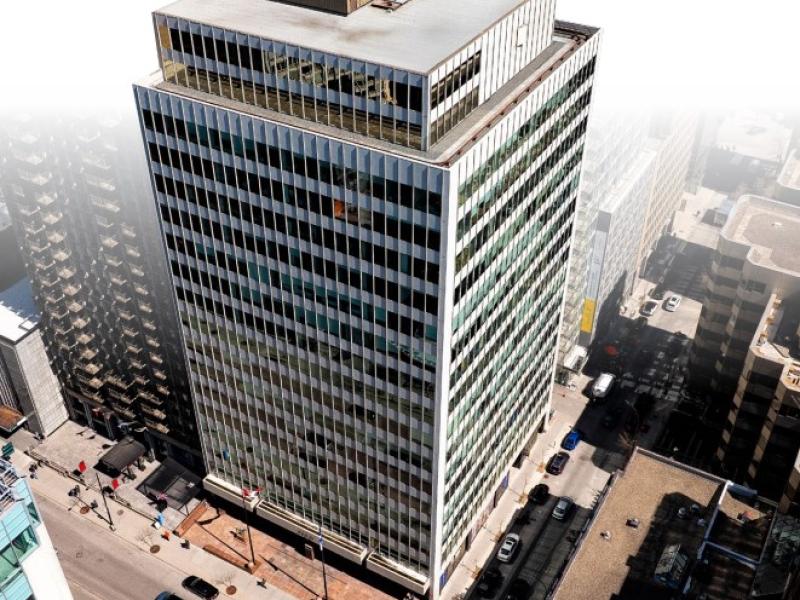
Vancouver’s office market has taken a step closer to stability as the overall national office market picture remains challenged by elevated vacancy and sluggish absorption by tenants.
In Vancouver, 2023 wrapped up with tenants taking 292,000 square feet of office space downtown, with 212,000 square feet of that absorption taking place in Q4 alone, according to the latest office data by brokerage firm CBRE.
Downtown Vancouver vacancy declined 80 basis points to 11 per cent thanks to several full-floor leases in class-A inventory, the report says. It notes that a continued, but gradual, rebound for the local office market should unfold now that the latest wave of new office development has come to an end.
“The word that I've been using a lot is stability,” said Jason Kiselbach, senior vice-president and managing director with CBRE in Vancouver.
Vacancy came down to close out the year and the market experienced most of its absorption in the latter half of 2023, Kiselbach told RENX: “I think (the market is) showing some positive signs . . . sooner than we were expecting.”
Over three million square feet under construction
Vancouver, which has an office inventory of about 52 million square feet, has 3.1 million square feet of office space currently under construction regionwide. About 1.1 million square feet of that space is in the downtown core and 90 per cent of that space is pre-leased.
Overall, the construction pipeline continues to lighten with no new major project launches in Q4 2023.
This trend is expected to continue in the year ahead with 1.8 million square feet anticipated to complete this year in downtown Vancouver and in Burnaby.
“The new supply cycle has been paused,” Kiselbach said. “I think that's a big benefit to the market here and we'll keep the vacancy rates a little bit lower than some other markets because we're not piling on new inventory when vacancy rates are elevated.
"So, the supply side of the equation is kind of solved at this point.”
Meanwhile, sublease listings in the region are reducing with total available sublease space dropping in Q4 for the first time in more than a year. The main drivers of that decline emerged from tenants taking full floors, tenants retaining their spaces and sublease listings expiring, the CBRE data showed.
CBRE reported the average class-A asking rent in the Vancouver region was $39.99 per square foot, which remains the highest in Canada.
Demand for space in Vancouver is broad
Demand for the new and subleased space has been broad-based, Kiselbach said.
“Our general economy is pretty diversified and that shows up in our tenant mix as well,” he said. “We've seen some leasing from tech companies, resource companies, professional services firms — primarily law firms — and then the education sector has been active.”
Most of the deals have been smaller, Kiselbach said, but noted that Q4 involved 16 separate full-floor office deals in Vancouver. “That’s a pretty solid number.”
There are nodes of strength outside of Vancouver’s downtown, Kiselbach said.
“Mount Pleasant and the Broadway corridor have continued to be really strong markets — super resilient — with good tenant demand and lease rates that have been holding pretty firm,” he said.
Vacancy in the suburban markets has been lower than downtown over the past few years, but that is expected to flip with the arrival of proportionally more new inventory in the suburban cities in the near future.
In its Q4 reporting, Colliers described Vancouver's office market as "relatively quiet," but noted regional vacancy had stalled at 8.6 per cent, including the suburbs.
The report said sublease space, while still available in greater quantities than pre-COVID, had been less prominent through 2023 as tenants took on shorter leases and chose move-in ready offices.
Canadian office situation still murky
Nationally, the office picture is mostly cloudy. Canada’s national downtown office vacancy rate hit a record high of 19.4 per cent in the final quarter of 2023, according to the CBRE data.
Toronto’s latest downtown office vacancy climbed from 15.8 per cent in Q3 to 17.4 per cent, due mostly to new supply. Just over 620,000 square feet of office space completed in Q4 alone. Overall, the market added 1.1 million square feet of new office space last year.
That played a role in the higher national rate however, as Ottawa, Calgary, Edmonton and Halifax all saw vacancy rates decline. However, in several of those markets a major contributing factor was conversions and removal of space from inventory - not major leasing activity.
Part of the challenge of filling up office buildings remains a lack of clarity around hybrid work and in-office policies.
Kiselbach said the return-to-office data varies quite a lot, but the general feel in Vancouver is that more people are back working in their offices.
“From a general and anecdotal standpoint, parking lots are more full, there's more foot traffic; restaurants are pretty full at lunch, so it does feel like those utilization and occupancy rates have definitely come up.”
Canadians in office more than they want to be, report says
A global survey released by JLL in November analyzed hybrid work data from employer and employee respondents.
It showed Canadian workers are spending an average of 3.6 days per week in the office, which is slightly more than they would prefer. Employee respondents indicated a preference to work 2.9 days in the office during an average week.
The global survey results showed that workers on average are spending 3.1 days in the office, suggesting Canadians are spending more time in the office than the global average. The percentage of global office workers who are purely remote fell from 14 per cent in early 2022 to two per cent in 2023.
The survey also showed that 58 per cent of global office workers felt the home environment better supported focus work.
Broader findings suggest employers need to do more to ensure the office environment is accessible, functional and supportive of productivity and that hybrid offices need to be set up better to meet the needs of workers. However, one of the largest barriers to coming to the office, in the minds of workers, are commute times and costs.
The report said 87 per cent of companies globally are encouraging working at the office, at least part-time, while roughly a third of companies have in-office mandates.










